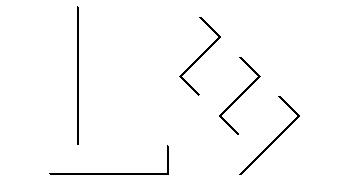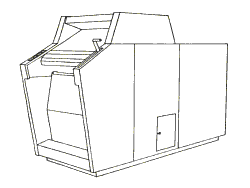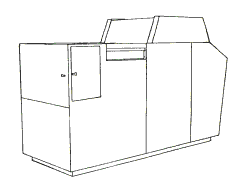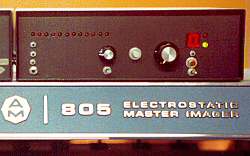LAUGHTON ELECTRONICS |
||
A Camera The Size Of A Refrigerator: the A-M 805 |
||
 |
This page discusses a machine which found its way into a lot of print shops, and which I was happy to offer service for. Also described are two 805's I modified in order to accommodate unique production situations. | |
|
|
The 805 platemaker is one of the machines I serviced back in the days when I worked for Addressograph Multigraph (aka A-M International). Like most of the more interesting machines I've seen, the 805 used not one but a variety of technologies: optics, electronics, electrostatics, xerography... Properly known as an Electrostatic Master Imager, the 805 was simply called a "camera" or "platemaker" by people in the printing industry. It'd be used to photograph black-&-white paste-ups or other artwork and text, and it reproduced the images on a specially coated paper master that could then be used as a plate on a printing press. The 805 was an odd looking beast, roughly the size of a large fridge or vending machine turned on its side. It had a handle at the front that opened and shut the so-called "copy door"; this was a two- by two-foot panel which acted as the mounting surface for the artwork being photographed. When opened, the copy door would rise and flip 90 degrees, allowing you to position your artwork on a horizontal surface. Then as you shut the door it would drop down and flip back to vertical, facing internal components such as the exposure lamps and the lens. An electrostatic process such as Xerox® uses dry powdered toner and a revolving drum with a photosensitive surface. The 805 uses the same sort of toner, but no drum is required because in this case the photosensitive surface is part of the medium itself; ie, the coated paper masters. After feeding into the machine and receiving its static charge, the master would be held stationary on a flat, horizontal surface during exposure. Impinging on it here would be the image, cast by the lens and a 45 degree mirror. Said lens and mirror were precision mounted on sliding rails and attached to levers that formed a sort of pantograph. Adjusting this assembly allowed one the flexibility to arbitrarily enlarge or reduce the size of the reproduced image. Servicing the 805 was a non-trivial task. The electrical controls were fairly reliable (despite the heavy reliance on 24-volt relay logic), but an alarming variety of things could degrade image quality, which is typically held to a very high standard in the graphics industry. Also there was plenty of botheration associated with the conveyors and electric clutch/brakes that carried the masters through the system. The most spectacular malfunctions involved the infrared fuser assembly, where masters would occasionally (and harmlessly) catch fire. |
|
|
new tricks: re-wiring the 805 to customer spec'sAfter leaving the A-M job to go freelance I began working on a far wider range of equipment, and 805 maintenance eventually evaporated from my agenda. However, I had two occasions to modify 805s. The first machine I modified was being used in a high volume situation, making master after master for hours on end. I boosted productivity about 15% by shaving 5 seconds off this machine's cycle time. Five seconds is how long it took the machine to bring a new master from the feeder to the exposure position, and my wiring changes allowed this to occur simultaneously with, rather than subsequent to, the operator loading new artwork and shutting the copy door. The changes meant that the master would already be in position by the time the door closed, and exposure could commence immediately. The other 805 modification was more complex. It provided a step-and-repeat function, essentially a double exposure technique that can sharply cut printing costs in certain situations. The goal was to load a single piece of artwork in the 805 and have it produce a master showing that same image twice. (When that master runs on the press, the press has higher productivity because it produces two copies of the image per revolution.) Implementing this function entailed removing the master-sense switch at the exposure position. Instead the master would stop at two exposure positions; this worked under control of a 12-bit counter and some other logic in conjunction with an encoder I installed on the transport. By means of the quadrature pulse train from the encoder, the master's travel could be precisely tracked as it approached and stopped at each exposure position. |
|
|
||
 |
||


